The cable row is an effective exercise for building your back muscles and increasing overall upper-body strength.
The cable row is a compound exercise that works for multiple muscle groups.
Different types of rows can be done with different attachments and grips.
In this guide, we’ll break down all aspects of the cable row so that you can get the most out of it.
- What is cable row?
- Muscle worked during cable row.
- How to perform the cable rows properly
- Best variations
- Tip and Techniques.

- What is Cable Row
- Different Attachment Used for Cable Row Exercise
- Cable Row – Hand And Grip Positions
- Muscle Worked During Cable Row
- 1. Close Grip Seated Cable Row
- How To Do Close Grip Seated Cable Row
- Tips
- 2. Wide Grip Seated Cable Row
- How To Do Wide Grip Seated Cable Row
- Tips
- 3. Chest Supported Cable Row
- How To Do Chest-Supported Cable Row
- 4. Underhand Grip Chest Supported Cable Row
- How To Do Underhand Grip Chest-Supported Cable Row
- Tips
- 5. Seated One Arm Cable Row
- How To Do Seated One Arm Cable Row
- 6. One Arm Standing Twisting Cable Row
- How To Do Single-Arm Standing Twisting Cable Row
- 7. Low Cable Row
- How To Do Low Cable Row
- Variations and Modifications to Change Cable Row Intensity
- Make it easier
- Make it harder
- Common Mistakes to Avoid When Doing Cable Row
- 1. Using Too Much Weight
- 2. Swinging Torso
- 3. Hunching Your Shoulders
- 4. Leaning too Far Forward
- 5. Rounding Your Back
- 6. Using Momentum
- 7. Reduced Range of Motion
- Benefits of the Cable row
- Best Alternatives Of Cable Row
- FAQs
- What is the difference between cable row and barbell row?
- How many sets and reps should I do for the cable row?
- What grip should I use for the cable row?
- Can cable row help with weight loss?
- Can cable row help improve grip strength?
- Takeaways
- References
What is Cable Row
Cable row is a strength training exercise that primarily targets the muscles in the upper back, shoulders, and arms.
It involves pulling a cable towards your body while sitting or standing in front of a cable machine.
This exercise can be performed in various ways to target back muscles from different angles.
- Seated or standing,
- Different grips positions
- Using different attachments
You can use different loads to put constant tension on your muscles for bigger gains.
Different Attachment Used for Cable Row Exercise
- V-bar attachment
- Wide D Handle Row Bar
- Straight bar
- Rope
- Zigzag Handle
- D Handle
Cable Row – Hand And Grip Positions
Here are some ways to alter your cable row to hit different muscles.
1. Overhand (Pronated) Grip
During an overhand grip, the elbow pushes out from the body, causing the upper back and rear delts to receive increased activation.
2. Underhand (Supinated) Grip
On the other hand, an underhand grip will force the elbows to stay close to the body.
This will generally cause greater activation of the middle and lower traps. You will get more bicep activation because of elbow extension.
3. Neutral Grip
However, its main benefit is that it takes stress off the elbow. People who have elbow pain will love using a neutral grip.
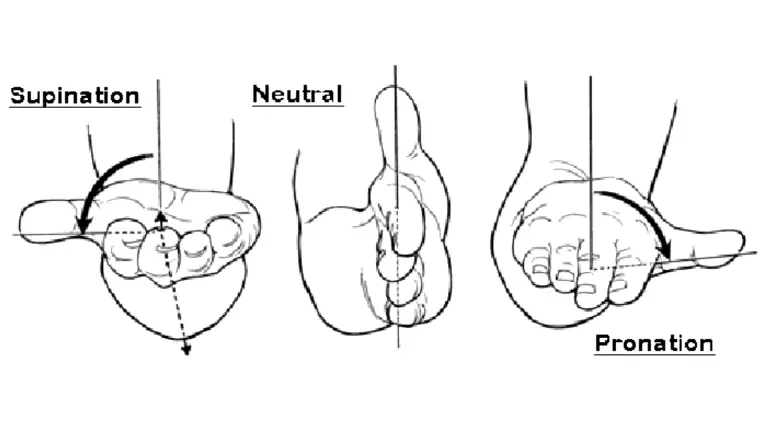
4. Narrow Grip
Using a narrow grip will help you hit your lats and middle and lower traps more.
Additionally, the biceps receive a greater workout with a higher range of motion.
5. Wide Grip
Using a wide grip will force you to use an overhand grip and force your elbows out. This will enhance the emphasis on the rhomboids, and rear deltoid.
Muscle Worked During Cable Row
The cable row is a compound exercise, which means it works many muscles simultaneously.
The main muscles worked during cable row are:
Secondary muscles worked during the rows:
- Rhomboids
- Biceps, brachialis
- Brachioradialis
- Infraspinatus
Antagonist Muscle worked: Chest, Triceps, Front deltoid.
The leg muscle groups are either accessory dynamic movement stabilizers or simple static support stabilizers.
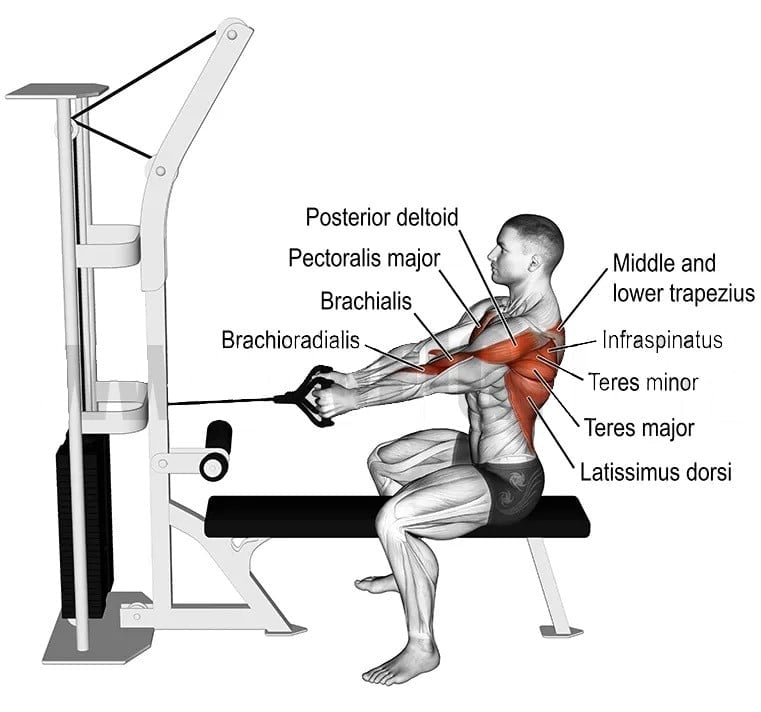
1. Close Grip Seated Cable Row
Seated cable rows are an excellent cable exercise for building middle back muscles, which also work on the lower back.
This back exercise is done on a cable rowing machine with different handles and grip positions.
- A pronated (overhand) grip targets the upper and middle trapezius.
- A neutral (thumbs up) grip hits the middle and lower trapezius.
- The supinated (underhand) grip switches the focus to the latissimus dorsi.

How To Do Close Grip Seated Cable Row
- Sit on a seated cable pulley rowing machine with legs slightly bent and feet supported against the crossbar.
- Take hold of the handles with your arms extended and back stretched.
- Pull the handles so that they come as close to the lower chest/abdomen as possible.
- Thrust your chest out while pulling with your body in an upright position.
- Slowly return the handle to the starting position.
Tips
- Keep your knees slightly bent to avoid knee and lower back pressure.
- Remember, a rounded back is a wrong back. Keep it straight at all times.
- Keep your upper back stationary; don’t move your upper back back and forth.
2. Wide Grip Seated Cable Row
The seated row is normally done with a narrow grip. If you want to make your back wider, use a wide grip.
Wide grip rows can strengthen your back because they mostly use the muscles in your upper back.
To do it correctly, be sure the movement is slow and fluid – no jerking or raising yourself up to push down with your body weight.
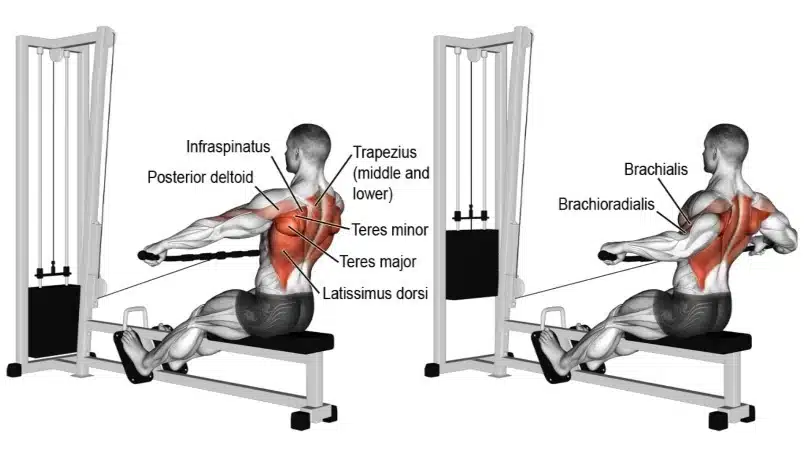
How To Do Wide Grip Seated Cable Row
- Sit on a seated cable pulley rowing machine with legs slightly bent and feet supported against the crossbar.
- Hold the bar with your arms slightly wider than shoulder-width apart.
- Pull the bar so that they come as close to the lower chest/abdomen as possible.
- Thrust your chest out while pulling with your body in an upright position.
- Slowly return the handle to the starting position.
Tips
- Locking your knees is stressful on the joints, so bending your knees slightly is best.
- To prevent rounding or arching, engage your abs and focus on keeping your spine straight.
- To fully activate your muscles, perform each rep slowly.
3. Chest Supported Cable Row
The chest-supported cable row is performed on a weighted horizontal cable machine with a bench.
Chest-supported rows are more evenly distributed, and you have more of a constant load on your back muscles throughout the whole range of motion.
The supported cable row can be performed with different grip positions and using different angles and attachments.
- Underhand grip
- Single-arm high row
- Neutral-grip,
- Rope attachment,
- Long bar
- Double arm low row….. Get creative!
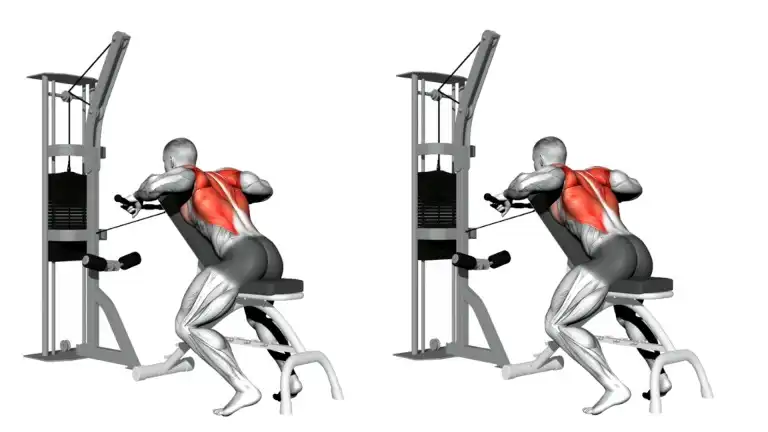
How To Do Chest-Supported Cable Row
- Attach a rope handle to a cable setup. Alternatively, you can use D-shaped handles on an extended strap.
- Adjust an incline bench to 30-45 degrees and place it in front of the cable machine, with the back facing the pulley.
- Sit on the bench with your chest against the backrest. Grip the handles and extend your arms.
- Pull your shoulders down and back, and brace your core.
- Bend your arms and pull the handles in toward your lower ribs.
- Lead with your elbows, keep your wrists straight, and squeeze your shoulders together to maximize upper-back engagement.
- Smoothly extend your arms, let your shoulders shrug forward to stretch your upper back, retract your shoulders again, and repeat.
4. Underhand Grip Chest Supported Cable Row
The Underhand grip chest-supported cable row is a great movement for shoulder girdle health and for creating balance in horizontal pulling and pushing (especially for the frequent bench-presser).
Maintaining proper form is also a bit easier than in dumbbell, bent-over rows.
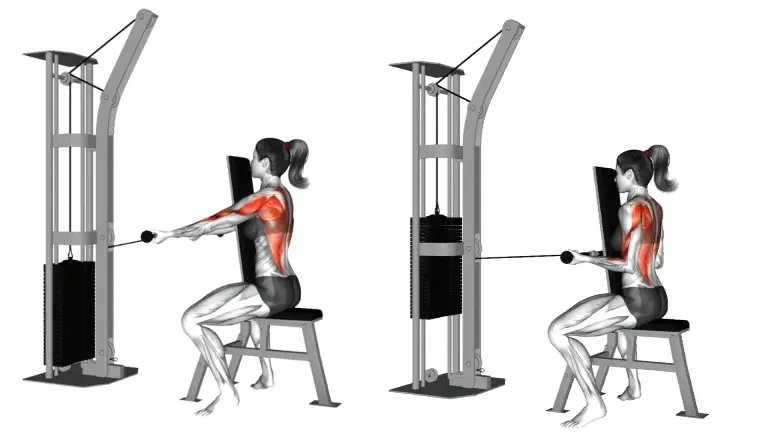
How To Do Underhand Grip Chest-Supported Cable Row
- Grip the handle underhand at shoulder width. Brace through the core before beginning the movement.
- Pull the handle to your chest, keeping your back upright and tight throughout the movement.
- Focus on bringing the shoulder blades together at the end of the range of movement.
- Return to the start position under control, maintaining the same braced position in your torso.
Tips
- You must not bend or flex the spine at any point.
- It is essential not to push the head forward at any movement.
- Focus on doing the full range of motion with your shoulder blades.
5. Seated One Arm Cable Row
The one-arm cable row is one of the best variations of the cable row movement, which trains the muscles of the upper back one side at a time.
There are many different ways to do the one-arm cable row exercise, such as standing, sitting, and twisting.
These variations can help you target different areas of your back muscles, engage your core muscles more, and provide a challenging workout.

How To Do Seated One Arm Cable Row
- Connect a single-handle attachment to the seated row.
- Place your right hand on the handle with a neutral grip (palm facing inwards).
- Sit on the bench and place your feet on the footplates.
- Hold the handle with your right hand directly before your belly button and extend both arms fully.
- Bend your right elbow to pull the handle in towards your right side; You should feel a small squeeze between your shoulder blades.
- Extend your arm and return to the starting position.
- Complete half of the specified repetitions on the same side before completing the remaining repetitions on the other side.
Tips
- Ensuring that your elbow remains in close contact with the side of your body.
- You may keep your back straight or allow it to sway back and forth in a controlled manner gently.
- Your reps should be slow and controlled to make the most of this move.
6. One Arm Standing Twisting Cable Row
The standing cable row is a compound exercise that works the upper back muscles of the posterior chain.
The standing and twisting motions of the exercise require greater core activation, which can help improve overall stability and balance.
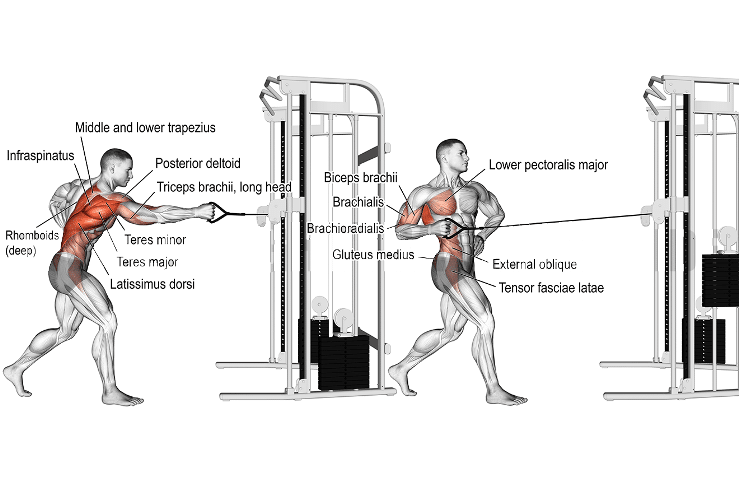
How To Do Single-Arm Standing Twisting Cable Row
- Start by standing facing a cable machine with a straight back and feet shoulder-width apart.
- Attach a single grip handle to the top of the cable pulley.
- Then, grab the handle with your right hand and step forward with your right foot.
- Engage your core and keep your back straight as you pull the cable towards your body.
- Keep your elbows close to your sides as you pull the bar towards your lower chest.
- As you pull the D handle towards your chest, twist your torso to the right, then return to the starting position.
- Repeat the exercise for the number of reps you want.
- Then, switch to your left.
7. Low Cable Row
The low cable row is a compound exercise primarily targeting your middle and upper back muscles. This also targets your lower back and core more effectively.
It’s performed on a cable machine with the pulleys set at the lowest position.
The low cable row can be performed in different grip positions and attachments.
- Underhand grip
- Single-arm high low-row
- V-Bar Neutral-grip
- Long bar… Get creative!
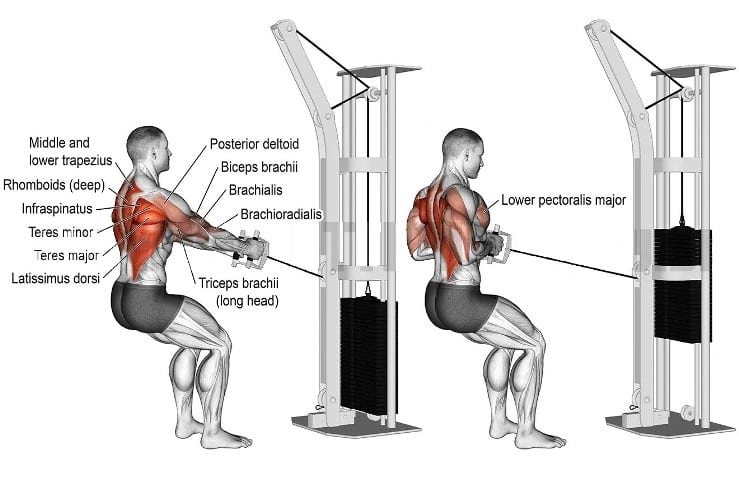
How To Do Low Cable Row
- Grab the rope with both hands, step back, and let your arms extend out.
- Bend slightly at the knees and waist to help stabilize yourself.
- Pull the handle towards your midsection, squeezing your shoulder blades together as you do so.
- Pause momentarily, then slowly release the handle back to the starting position.
- Repeat for the desired number of reps.
Know More: 18 Best Cable Back Workout And Exercises For Wider Back
Variations and Modifications to Change Cable Row Intensity
You can modify your seated cable rows to match your fitness level.
Make it easier
If you are new to performing a cable seated row, you may want to apply a few modifications to make the exercise easier.
- Start with lightweight and low reps.
- Increasing the weight and reps once you can do the exercise with perfect form.
Make it harder
When you’ve mastered form and can complete the standard cable row exercise with control and strength, it’s time to challenge yourself with variations.
If you want to work different muscle fibers in the back or if your seated rows are too easy, try these modifications:
- When you use a chest-supported seated row, your trunk must work harder to stay still.
- You can pull the cable with one arm at a time or pull it with one arm along the side of your body.
- At the end of the pulling phase, pause for 3 to 5 seconds to challenge your muscles.
Common Mistakes to Avoid When Doing Cable Row
Doing the exercise correctly is important to avoid injury and get the most out of your workout.
Here are some common mistakes you should avoid when doing cable row.
1. Using Too Much Weight
Using the right weight makes a world of difference. Start lighter, master the form, and see those muscle gains soar!
2. Swinging Torso
Remember, this is a back exercise, not a core workout. Brace that core, keep your torso stable, and let your back muscles do the work.
3. Hunching Your Shoulders
Hunching your shoulders can cause strain on your neck and shoulders.
Stop those hunches! Imagine pulling your shoulder blades down and towards each other, protecting your shoulders and getting a killer back workout.
4. Leaning too Far Forward
Leaning too far forward can put a strain on your lower back.
Instead, keep an upright posture and use your core muscles during the exercise. Protect your lower back, get a more effective workout, and feel unstoppable.
5. Rounding Your Back
Always keep a neutral position. To prevent rounding or arching, keep your spine straight and engage your abdominals.
6. Using Momentum
To fully activate your muscles, you should perform each rep slowly. It is best to avoid rapid and jerky movements.
7. Reduced Range of Motion
If the weight is too heavy, you can’t properly do the full range of motion.
Reduce the weight and ensure you have a full range of motion for this exercise.
Benefits of the Cable row
- The cable row improves overall upper body strength.
- It helps improve posture by strengthening the upper back and shoulder muscles.
- It is a low-impact exercise, making it a viable option for people with joint or lower back pain.
- Cable row allows for a greater range of motion than other rowing exercises.
- It improves posture and reduces the risk of back pain.
- Enhanced grip strength.
- Improved overall athletic performance. It’s good for athletes who do sports that require upper body strength and stability, like rowing, swimming, or tennis.
Best Alternatives Of Cable Row
You can try these alternatives if you’re looking for a similar exercise to replace the cable row during your training sessions.
FAQs
What is the difference between cable row and barbell row?
Cable row involves pulling a cable towards your body using a handle or attachment, while barbell row involves lifting a barbell off the floor and pulling it towards your body.
A cable row allows for a greater range of motion and can be easier on the lower back, while a barbell row can be more challenging and involve more muscles.
How many sets and reps should I do for the cable row?
- For muscle endurance: Aim for 3-4 sets of 12-15 reps, with moderate resistance.
- For muscle strength: Aim for 3-5 sets of 6-10 reps, with more resistance.
- For muscle hypertrophy (increased muscle size): Aim for 3-4 sets of 8-12 reps, with a moderate to heavy amount of resistance.
What grip should I use for the cable row?
For cable row, different handle attachments are available, and the grip you use can target different muscles.
For example, a wide grip can target the upper back muscles, whereas a neutral grip can target the mid-back muscles.
Try different grips to find the one that works best for you.
Can cable row help with weight loss?
Cable row can be part of a weight loss program because it helps build lean muscle mass and increases overall calorie burn.
However, combining strength training with a healthy diet and cardiovascular exercise is important to lose weight.
Can cable row help improve grip strength?
Yes, the cable row can improve grip strength.
Takeaways
Cable row is a great exercise for targeting the muscles in the upper back and improving posture.
Different handle attachments are available for cable row, and the grip you use can target different muscles.
If you want to build strength, grow muscle, or train, choose the cable row variation that suits your fitness level.
References
- Schoenfeld, Brad MSc, CSCS; Kolber, Morey J PT, PhD, CSCS; Haimes, Jonathan E BS, CSCS: The Upright Row: Implications for Preventing Subacromial Impingement. Strength and Conditioning Journal: October 2011 – Volume 33 – Issue 5 – p 25-28
- Cools AM, Witvrouw EE, Declercq GA, Danneels LA, Cambier DC. Scapular muscle recruitment patterns: Trapezius muscle latency with and without impingement symptoms. Am J Sports Med 31: 542–549, 2003.
- Int J Environ Res Public Health. Trapezius muscle timing during selected shoulder rehabilitation exercises. 2021 Jun 14;18(12):6444. doi: 10.3390/ijerph18126444.PMID: 34198674
- Lorenzetti S, Dayer R, Pluss M, List R. Pulling exercises for strength training and rehabilitation: movements and loading conditions. J Funct Morphol Kinesiol. 2017;2(3):33. doi:10.3390/jfmk2030033
- Chad M J Fenwick, Stephen H M Brown, Stuart M McGill. Comparison of different rowing exercises: trunk muscle activation and lumbar spine motion, load, and stiffness. PMID: 19620925 DOI: 10.1519/JSC.0b013e3181b07334
- Jett, David Michael Jr. M.S., C.S.C.S., EP-C, PN; Gibb, Jessica M.S., CEP, EP-C, FMSC; Verrill, David E. M.S., RCEP, CEP, PD, FAACVPR. Evidence-based Alternatives To Popular Exercises. ACSM’s Health & Fitness Journal: November/December 2017 – Volume 21 – Issue 6 – p 20-26.
- Tataryn N, Simas V, Catterall T, Furness J, Keogh JWL. Posterior-chain resistance training compared to general exercise and walking programmes for the treatment of chronic low back pain in the general population: a systematic review and meta-analysis. Sports Med Open. 2021;7:17. doi:10.1186/s40798-021-00306-w

Manish brings over 10 years of hands-on experience in weight lifting and fat loss to fitness coaching. He specializes in gym-based training and has a lot of knowledge about exercise, lifting technique, biomechanics, and more.
Through “Fit Life Regime,” he generously shares the insights he’s gained over a decade in the field. His goal is to equip others with the knowledge to start their own fitness journey.
